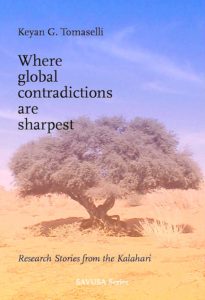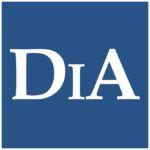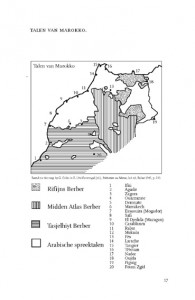Where Global Contradictions Are Sharpest ~ Textualising The San ‘Past’: Dancing With Development
 The ‘exterminating’ impact of Uys’ The Gods must be crazy (1980) on the Ju/’hoansi, is a topic discussed by Robert Gordon (1992: 1). This film’s use of tongue-in-cheek documentary codes includes the ‘pseudoscientific narrator’ humorously relating the central San character’s first encounters with the signs of modernity (a coke bottle, tyre tracks in the sand, etc.). This narration draws on the naturist perceptions of the Other, so successfully popularised by early anthropology, and by commentators like Ross (1976), and Davis’ informants (1954).[i]
The ‘exterminating’ impact of Uys’ The Gods must be crazy (1980) on the Ju/’hoansi, is a topic discussed by Robert Gordon (1992: 1). This film’s use of tongue-in-cheek documentary codes includes the ‘pseudoscientific narrator’ humorously relating the central San character’s first encounters with the signs of modernity (a coke bottle, tyre tracks in the sand, etc.). This narration draws on the naturist perceptions of the Other, so successfully popularised by early anthropology, and by commentators like Ross (1976), and Davis’ informants (1954).[i]
Alby Mangels’ commentary in Adventure bound (1993) sums up the debilitating Western common sense: ‘They do not seem to carry the pressure of the past as we do in the West’. Trapped in time as the Bushmen are, all ‘we’ (the West) can do is ‘dance’ (with them) as the encounter straddles ‘then’ and ‘now’. What is ironic in Mangels’ commentary is that it unwittingly intercepts a root metaphor for Ju/’hoansi symbolic action. The ritual of dancing offers a way of accessing ‘boiling energy’ to effect spiritual contact, healing and to address dislocations in the harmony of quotidian life (cf. Katz et al. 2001; Katz 1982). Mangels’ visualisation of this idea, however, evokes a Western view of the Bushmen as non-rational, given to instinctive impulses rather than intellectual cognition. The result is to exoticise an activity that has serious cultural and spiritual dimensions. I now turn to our negotiation of the multiple texts – popular memory, film, and social – that we encountered in Otjozondjupa.
Development: Dancing with time
Otjozondjupa is serviced by the Nyae Nyae Development Foundation of Namibia (NNDFN) and various state agencies (Health, Environment, and through the often erratic provision of food rations). While we were there in July 1996, the average individual calorie intake was 2,500 a day. This dropped to 1,000 in 1997, when government rations were not delivered (P. Wiessner, Personal comment, 5 April 1998). We interviewed villagers at N/aqmtjoha and the /Aotcha Pan on the films about them, and especially on their perception of the Herero, who were pushing northwards into Otozondjupa with their cattle.
Photo-elicitation techniques applied by Jeursen and Morgan, with regard to a 1992-Spoornet calendar in which ‘Bushmen’ are shown to be living in traditional and environmental splendour, however, revealed no agreement that life ‘long ago’ was better than it is now. The ‘old days’ were a ‘hard existence’, the villagers of Kapteinspos told us.
Some informants at /Aotcha Pan explained that their contemporary settled existence was better in quality than the indeterminate time reflected on the calendar.[ii] Some of these informants included the now elderly people who had first met the Marshalls in the early 1950s – ‘Kaptein’ Kgau//au and !U, amongst others. From his experience of translating the sound tracks at DER in 1994, ≠Oma Tsamkxao observed that he had learned about the history of the Ju/’hoansi from these films: ‘I heard about their complaint of how they lived in the old days and how they live now. I can say now that the Bushmen in the old days had no option or opportunity to have an education or lead a better life … The children can go to school and study’.
The Ju/’hoansi conception of history in terms of “the old days” or “long ago”, is described by Lorna Marshall (1976: 53):
Although they look respectfully to the past, they are not history-minded. They make no effort to hold actual past events systematically in mind or teach them to their children – neither events that concern the living people nor those concerning their forebears. They remember what they happen to remember their father and grandfathers telling them.
Read more
Where Global Contradictions Are Sharpest ~ Stories To Tell, Stories To Sell: Hidden Transcripts, Negotiating Texts
 Post-Birmingham cultural studies have been severely criticised for offering little more than a ‘“white on white” textual orientation’ (Giroux and McLaren 1994: x). Edward Said (1979: 93) writes of a ‘textual attitude’, which prefers ‘the schematic tendency of a text to the disorientations of direct encounters with the human’. The mess and confusion found in everyday life, as well as the supernatural is ‘bracketed out’ because they obscure the clarity of the structure (Husserl 1969). Texts become walls that academics insert between ‘us’ and ‘them’ to protect ‘us’ from having to deal with the ambiguities, contradictions, and confusion of everyday life (Malan 1995; Conquergood 1998; Pollock 1998). Students often delight in the prospect of analysing oral literatures in typed translation, via the application of the usual post-structuralist French gurus. The result inevitably is a white, usually French-shaped Eurocentric reading of oral and other narratives in non-European regions.
Post-Birmingham cultural studies have been severely criticised for offering little more than a ‘“white on white” textual orientation’ (Giroux and McLaren 1994: x). Edward Said (1979: 93) writes of a ‘textual attitude’, which prefers ‘the schematic tendency of a text to the disorientations of direct encounters with the human’. The mess and confusion found in everyday life, as well as the supernatural is ‘bracketed out’ because they obscure the clarity of the structure (Husserl 1969). Texts become walls that academics insert between ‘us’ and ‘them’ to protect ‘us’ from having to deal with the ambiguities, contradictions, and confusion of everyday life (Malan 1995; Conquergood 1998; Pollock 1998). Students often delight in the prospect of analysing oral literatures in typed translation, via the application of the usual post-structuralist French gurus. The result inevitably is a white, usually French-shaped Eurocentric reading of oral and other narratives in non-European regions.
Reverse cultural studies: Voices from the field
Academy-bound textualist scholarship claiming to be studying the ‘popular’, though often exquisitely analysed and written, tends to background quotidian empirical significance. Detail, immediacy, and self-reflexivity are as important as is texualised theory, in which human agency is described and recognised, and in which voices from the field, our ‘subjects of observation’, are engaged by researchers as their equals (in human dignity and thus as co-producers of knowledge).
The analytical textualist disjunction between distance and immediacy, separation and immersion, exploitation and collaboration, holds that ‘there is nothing outside the text’ (Jackson 1989: 184). Textualism thus legitimately ignores the flux of human interrelationships and the ways in which meanings are intersubjectively integrated, embodied in gestures and performance, as well as in words (Jousse 1997; Bakhtin 1986: 6). De Saussure’s semiological logic, for example, imprisons us in a nominalist world of linguistic structures. If semiology is itself one such structure, then trying to ‘see through’ it leaves nothing to which reference can be made, except possibly some prior structure in a potentially infinite regress (Shepperson and Tomaselli 1999).
One result of textualism, and especially binary assumptions in some studies and the popular imagination, is to assume the myth that the ‘Bushmen’ have ‘disappeared’ and that when they were ‘living’, they always only had one ‘way of life’. Such analyses, which pepper much contemporary literature, lack historical periodisation, and assume that all San speak/spoke only one language (cf. Wilmsen 1986a for a critique of this position; also see Chapman 1996: 21-31). This homogenizing effect is the result of antecedent theorising about the indigenous other as an undifferentiated mass, an authorising of the textual over its relationship with the contextual, and of assumptions about history.
In the postmodern age of hyper-mediated realities and fractured development periodisations, the Other becomes a resource for discursive rearticulation, integration, and expropriation. The mythical images, sounds, and values offered by so-called First Peoples are appropriated by advertisers to expropriate long-lost mythical images to sell something (in South Africa, for example, cars [Mazda], telephone services [Telkom], toothpaste [Colgate], railways [Spoornet], an Internet book store [Kalahari.net], Game Parks [Kagga Kamma], a cut price airline [Kulula.com], and others). What is sold has nothing to do with the ‘actors’ (whether real or imagined), but with the imperative of capital, which integrates anything that communicates into messages that encourage consumption. Ironically, the very people used to retail such products are themselves largely unable to afford them. They remain materially isolated from the very texts they are promoting, de-linked from consumption despite their performance, and in spite of their textualisation and inter-textualisation. Nothing – not epistemology, not ways of seeing – is unsettled in the exchange. They remain ‘them’; we remain ‘us’, secure in our distanced otherness.
Read more
Where Global Contradictions Are Sharpest ~ References
This list relates to the first formal interviews conducted. Supplementary interviews were obtained throughout the ten-year study period. The dates of these comments are provided in the text.
American tourists (2001), interviewed at Kaa, Botswana, July.
Carter, R. (2000), interviewed at Witdraai, Northern Cape, September.
Festus, A. (2000), interviewed at Witdraai, Northern Cape, September.
Kleynhans, L. (2002), interviewed at Andriesvale, Northern Cape, 4 April.
Kruiper, B. (2002), letter to Vanessa McLennan-Dodd, January.
Kruiper, B. (2002), interviewed by Lauren Dyll and Keyan Tomaselli, at Blinkwater, Northern Cape, 19 July.
Kruiper, B. (2001), interviewed by Vanessa McLennan-Dodd at the University of Natal, Durban, 18 October.
Kruiper, B. (2001a), interviewed at Witdraai, Northern Cape, 24 July.
Kruiper, B. (2001b), interviewed at the University of Natal, Durban, October.
Kruiper, B. (2000), interviewed at Blinkwater, Northern Cape, July.
Kruiper, B. (2000), letter recorded in the Northern Cape, March.
Kruiper, D. (2000), interviewed at Witdraai, Northern Cape, September.
Kruiper, I. (2001), interviewed at Ostri-San, North West Province, 8 November.
Kruiper, T. (2002), interviewed at Witdraai, Northern Cape, 17 July.
Kruiper, V. and Van Wyk, S. (2001), interviewed by Nelia Oets and Keyan Tomaselli at Blinkwater, Northern Cape, 20 July.
Malgas, J. (2002), interviewed at Witdraai, Northern Cape, 5 April.
Meintjies, A. (2001), interviewed at Witdraai, Northern Cape, July.
Motshabise, M. (1995), interviewed by Belinda Jeursen at Ngwatle, Botswana.
Motshabise, M. (1999), interviewed at Ngwatle, Botswana, June.
Motshabise, M. (2000), interviewed by Keyan Tomaselli and Anthea Simões at Ngwatle, Botswana, July.
Motshabise, P. (1999), interviewed at Ngwatle, Botswana.
Motshabise, M. and P. (2001), interviewed by Belinda Jeursen at Monong, Botswana, July.
Nxai, J. (2001), interviewed at Ngwatle, Botswana, July.
Nxai, K.J. (2002), interviewed at Ngwatle, Northern Cape, July.
Nxai, K.J. and Nxai, J. (2001), interviewed at Ngwatle, Botswana, July.
Nxai, P. (1999), interviewed by Mashilo (Gibson) Boloka at Ngwatle, Botswana, June.
Orileng, G. (1999), interviewed by Mashilo (Gibson) Boloka at Ngwatle, Botswana, June.
Padmaker, D. (1999), interviewed at Biesjepoort, recorded and transcribed by M. Lange.
Rooi, Ouma !Una (2000), interviewed by Keyan Tomaselli, Anthea Simões and Chantel Oosthuysen at Witdraai, Northern Cape, 27 September.
Vaalbooi, P. (2000), interviewed by Keyan Tomaselli, Chantel Oosthuysen and Anthea Simões in the Northern Cape, 29 September 2000.
Waldron, R. (1995), interviewed by Belinda Jeursen at Ngwatle, Botswana, April.
Decolonising the University: The African Politics Reading List
 Democracy in Africa ~ In response to requests from colleagues and friends, we have assembled a reading list on African Politics. This reading list is collated in solidarity with those who are currently attempting to decolonise the university across Africa, and beyond. We welcome your recommendations of outstanding scholarship to add to this bibliography.
Democracy in Africa ~ In response to requests from colleagues and friends, we have assembled a reading list on African Politics. This reading list is collated in solidarity with those who are currently attempting to decolonise the university across Africa, and beyond. We welcome your recommendations of outstanding scholarship to add to this bibliography.
NB: Currently, this list focuses on English translations and texts but we are in the midst of developing lists in other languages and would welcome your suggestions below.
Go to: http://democracyinafrica.org/decolonising-the-university-the-african-politics-reading-list/
Ikkattinn – Berberse volksverhalen uit Zuid-Marokko
In Noord-Afrika worden van oudsher Berberse talen gesproken. De geschiedenis leert ons dat het altijd al een gebied is geweest waar verschillende culturen elkaar hebben ontmoet en waar verschillende talen naast elkaar hebben bestaan.
Zo werd er tijdens de Romeinse overheersing van Noord-Afrika (van de tweede eeuw voor Christus tot de zesde eeuw na Christus), naast genoemde Berberse talen, Latijn en Punisch gesproken. In het begin van de achtste eeuw na Christus begon de islam zich over Noord-Afrika uit te breiden en dat bracht een verspreiding van Arabische spreektalen met zich mee. Dit proces verliep in het ene gebied langzamer dan in het andere. Zo was waarschijnlijk de overgrote meerderheid van de Marokkaanse bevolking tot ver in de 19e eeuw Berbertalig. In Marokko werden tijdens de periode van koloniale overheersing (1912-1956) Frans en Spaans aan de reeds aanwezige talen toegevoegd.
“In negen landen van Noord-Afrika worden tegenwoordig Berberse talen gesproken. Het totale aantal sprekers is ongeveer vijfentwintig miljoen. We onderscheiden acht à tien verschillende Berberse talen die weliswaar taalkundig sterk verwant, maar in praktijk in wisselende mate onderling verstaanbaar zijn. Als taalfamilie behoren Berberse talen bij het Afroaziatisch”.
Verreweg de meeste Berbertaligen vinden we in Marokko, een land met 30 miljoen inwoners. Naar schatting de helft van de Marokkanen spreekt van huis uit een van de drie Marokkaanse Berberse talen (voor de geografische verspreiding zie het kaartje): Rifijns Berber (Tarifiyt) in het noorden, met ongeveer twee miljoen sprekers; Midden-Atlas Berber (Tamazight) in het midden, met ongeveer vier miljoen sprekers en Tasjelhiyt Berber (Tasjelhiyt of Tasusiyt) in het zuiden, met ongeveer negen miljoen sprekers.
Veel Berbertaligen zijn uit hun oorspronkelijke woongebied geëmigreerd, zowel naar gebieden binnen hun eigen vaderland als naar andere landen. De grootste stad van Marokko, Casablanca, is voor zestig procent Berbertalig; één op de twaalf inwoners van Parijs spreekt een Berberse taal.
Als gevolg van arbeidsmigratie vanuit Marokko, vanaf de jaren zeventig van de vorige eeuw, hebben zich in Nederland veel Marokkanen gevestigd. Thans, 2005, wonen er ongeveer 300.000 Marokkanen in Nederland. Hiervan is driekwart Berbertalig, dus ongeveer 220.000 mensen, waarvan waarschijnlijk 180.000 Rifberbers en 40.000 Berbertaligen uit de Midden-Atlas en Zuid-Marokko.
Het Tasjelhiyt Berber van Zuid-Marokko is naar aantal sprekers de grootste Berberse taal van Marokko. De noordelijke grens van het Tasjelhiyt Berber-taalgebied wordt gevormd door de noordelijke rand van de Hoge-Atlas; de zuidelijke grens is de denkbeeldige lijn van Foum Zguid, een plaats ten zuiden van Ouarzazate, in het oosten, tot het plaatsje Ifni aan de kust in het westen. De oostelijke grens is de denkbeeldige lijn van Demnate, over Ouarzazate naar Foum Zguid. De westelijke grens is de kust van de Atlantische oceaan, tussen de steden Essaouira en Ifni. Ten zuiden van de stad Demnate gaat het Tasjelhiyt Berber geleidelijk over in het Berber van de Midden-Atlas.
as-Sûs al-Aqsâ
Het Tasjelhiyt Berberse taalgebied, dat in oppervlakte ongeveer vier keer zo groot is als Nederland, was bij de oude Arabische geografen en historici bekend als as-Sûs al-Aqsâ “de verafgelegen Sous”. De Sous is de naam van de grote vlakte ten oosten van Agadir. Vandaar dat het Tasjelhiyt Berber ook wel Sous Berber wordt genoemd. In Franstalige werken noemt men deze taal gewoonlijk “Chleuh” of “Tachelhiyt”. Read more
The Open Library of Humanities
 The Open Library of Humanities (OLH) is a charitable organisation dedicated to publishing open access scholarship with no author-facing article processing charges (APCs). We are funded by an international consortium of libraries who have joined us in our mission to make scholarly publishing fairer, more accessible, and rigorously preserved for the digital future.
The Open Library of Humanities (OLH) is a charitable organisation dedicated to publishing open access scholarship with no author-facing article processing charges (APCs). We are funded by an international consortium of libraries who have joined us in our mission to make scholarly publishing fairer, more accessible, and rigorously preserved for the digital future.
The OLH publishing platform supports academic journals from across the humanities disciplines, as well as hosting its own multidisciplinary journal. Launched as an international network of scholars, librarians, programmers and publishers in January 2013, the OLH has received two substantial grants from the Andrew W. Mellon Foundation to date, and has built a sustainable business model with its partner libraries.
All of our academic articles are subject to rigorous peer review and the scholarship we publish showcases some of the most dynamic research taking place in the humanities disciplines today – from classics, modern languages and cultures, philosophy, theology and history, to political theory, sociology, anthropology, film and new media studies, and digital humanities. Our articles benefit from the latest advances in online journal publishing – with high-quality presentation, annotative functionality, robust digital preservation, strong discoverability and easy-to-share social media buttons.
Our mission is to support and extend open access to scholarship in the humanities – for free, for everyone, for ever.
Go to: https://www.openlibhums.org/



